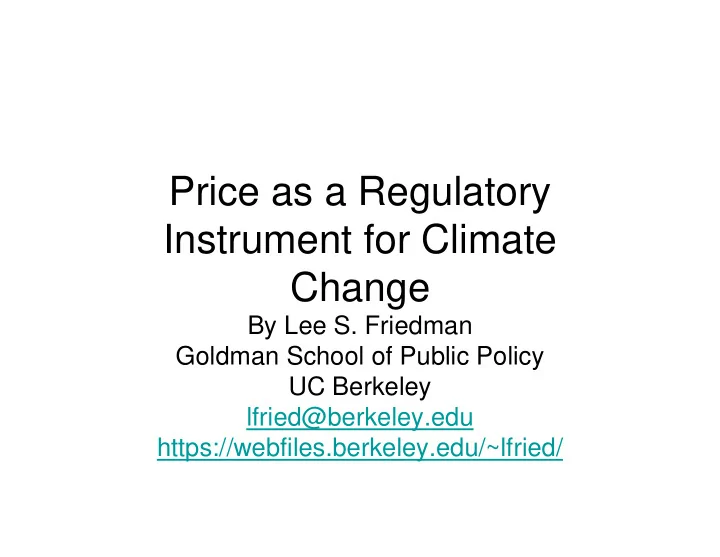

Price as a Regulatory Instrument for Climate Change By Lee S. Friedman Goldman School of Public Policy UC Berkeley lfried@berkeley.edu https://webfiles.berkeley.edu/~lfried/
Some Emissions are Costly to Reduce, Others not so Costly The height of the red line shows the cost of reducing each ton, or the emitter’s maximum willingness to pay in order to emit it The Emitter’s High WTP Willingness to Pay (WTP) to Low WTP Emit each “Low-Hanging Fruit” Ton 0 Current Level Tons of Carbon Emitted 2
Emissions arise from a myriad of circumstances • Examples of high-hanging fruit: a coal-fired electricity plant that can only reduce emissions by expensive sequestration; trucking or bus companies who own large fleets of last year’s inefficient gas guzzlers; refrigerators that rely on fossil-fuel fired electricity sources; the travelling salesman who needs to carry his samples in a motor vehicle. • Examples of low-hanging fruit: the car commuter who can easily be induced to take mass transit or to buy a new energy-efficient Prius; firms and consumers that can be easily induced to replace conventional bulbs with compact fluorescents. • Each of us, whether acting as consumers or in our businesses, probably causes some emissions that are “low-hanging fruit” (easy for us to reduce) and other emissions that are “high-hanging fruit” (hard for us to reduce). • We can reduce emissions both by technology (a better car or light bulb) and by behavior (reduced driving, less use of air-conditioning) 3
If Carbon Emissions are Priced, This Same Curve is Also a Demand Curve for Emitting Carbon The regulator cannot know which of all emissions are low-hanging and which are high-hanging. But the regulator can charge for emissions, and let individuals and firms decide for themselves. The reductions are achieved at the least possible total cost. Price per ton Emitted The horizontal distance from the vertical axis shows the quantity of emissions (Q 1 ) for each possible fee (P 1 ) P 1 0 Q 1 Current Level Q 0 Tons of Carbon Emitted 4
Based on Current Technology, Guesstimates of the Fee Rates Necessary to Achieve the 2020 and 2050 Emissions Reduction Goals Price per ton Emitted $80 ? $30 ? 0 427 85 480 Tons of CO2e Emitted in California (Metric Millions ) 5
A Cap-and-Trade Program Trading Opportunities after the Initial Allowance Distribution [ Green = seller and Blue = buyer] If the allowances were Price per ton sold at auction, the state Emitted would raise $14.4 billion $40 $30 $10 427 0 85 480 Tons of Carbon Emitted in California (Metric Millions) 6
Fee Approach: Government Sets Price Cap-and-Trade: Government Sets Quantity Price Fee System: Government Sets per ton Price, Market Finds Quantity Emitted Cap and Trade: Government Sets Quantity, Market Finds Price $30 0 427 85 480 Tons of Carbon Emitted in California (Metric Millions) 7
We Don’t Know where the Red line is Located. Suppose All We Know is that the True Emissions Demand Curve is Between the Blue and Green Lines Price per ton Emitted $40 $30 $5 0 85 427 480 Tons of Carbon Emitted in California (Metric Millions) 8
Cap-and-trade has Price Uncertainty If we set a cap at 427, allowances prices will be somewhere between $5 and $40 per mmt. Price per ton The 53 mmt emissions Emitted reductions are still achieved at the least possible cost. The Acid Rain program for SO2 costs firms and their customers 33-50% less than $40 “command and control” type $15 regulation. $5 0 85 427 480 Tons of Carbon Emitted in California (Metric Millions) 9
The Carbon Fee has Quantity Uncertainty If we set a fee at $30 per mt, the amount of emissions will be somewhere between 360 and 460 mmts. Price per ton Emitted $30 0 360 85 460 427 480 Tons of Carbon Emitted in California (Metric Millions) 10
Carbon Emissions Pricing Is a Long- Term Process Alternative Time Paths to Meet State Emission Reduction Goals Millions Metric Tons Emissions Emissions (Constant Year (Linear) Depreciation) -13.75/yr., 2.82%/yr., -11.4/yr. 5.24%/yr. 2012 537 537 2015 496 493 2020 427 427 2025 370 326 2030 313 249 2035 256 191 2040 199 146 2045 142 111 2050 85 85 2055 28 65 11
The Main Short-Run Uncertainty is in Getting Started, Not from Year-to-Year once Started EU ETS Allowances by Price in Euros as of 5/08 Year of Issue Dec 2008 26.06 Dec 2009 26.68 Dec 2010 27.41 Dec 2011 28.10 Dec 2012 29.08 12
Long-Run Uncertainty is Due to Technological Progress and New Scientific Understandings of Climate Change. Emissions Pricing will cause Technological Progress, and Technological Progress will affect Emissions Prices 13
Recommend
More recommend